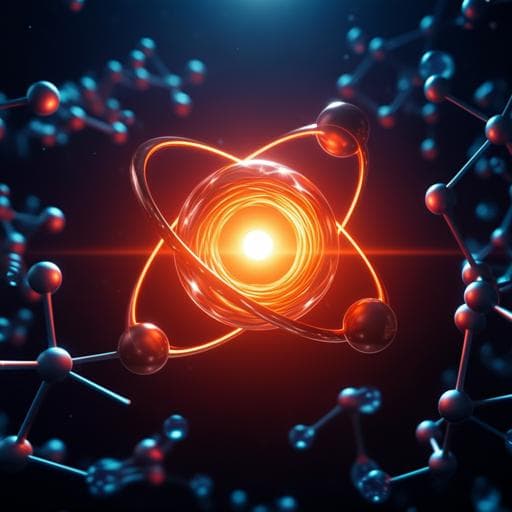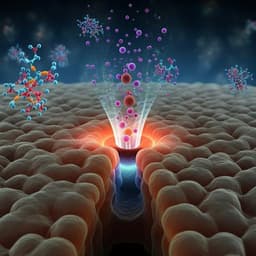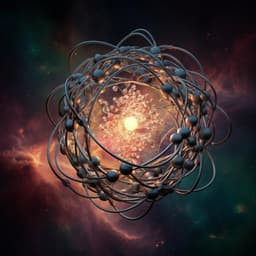
Chemistry
Single-atom Cu anchored catalysts for photocatalytic renewable H₂ production with a quantum efficiency of 56%
Y. Zhang, J. Zhao, et al.
This groundbreaking research by Yumin Zhang and colleagues unveils a new method to achieve a high loading of copper single-atoms on TiO₂, elevating H₂ evolution rates to an impressive 101.7 mmol g⁻¹h⁻¹ under simulated solar light. The method promises not just efficiency but exceptional stability, lasting over 380 days.
~3 min • Beginner • English
Introduction
The study addresses the challenge of improving photocatalytic hydrogen evolution using TiO₂, which suffers from high charge-carrier recombination and slow proton reduction kinetics. Conventional strategies (doping, defect engineering, heterojunctions, morphology control) offer limited gains. Cocatalyst loading enhances charge separation, but noble metals (Pt, Au, Pd) are costly and still yield moderate efficiencies. Transition metals are cheaper but often suffer from low atom utilization due to bulk cocatalyst forms. Single-atom catalysts (SACs) maximize active site utilization but typically aggregate at loadings above ~0.5 wt%, limiting activity and reproducibility. The research question is whether a synthetic strategy can stabilize a high loading (>1 wt%) of atomically dispersed Cu on TiO₂ to achieve superior and durable H₂ evolution, leveraging reversible Cu²⁺/Cu⁺ redox for efficient electron capture and water reduction.
Literature Review
Prior work shows noble metal cocatalysts (e.g., Pt) significantly enhance TiO₂ photocatalysis (e.g., 12-fold improvement), yet cost and moderate efficiencies remain issues. Transition metal cocatalysts (Cu, Ni, Co, Fe) have been explored as alternatives. SACs have gained attention for maximizing active sites, improving reactions including H₂ evolution, CO₂ reduction, and dye degradation; however, most reports achieve only ~0.1–0.3 wt% loading due to aggregation and instability, particularly with post-treatment syntheses (e.g., impregnation). A wrap-bake-peel strategy for Cu SACs on TiO₂ previously achieved a benchmark AQE of 45.5% at 340 nm but required regeneration of active sites. The easy valence switching of Cu (Cu²⁺/Cu⁺) suggests potential for efficient charge separation and catalytic activity, potentially rivaling or surpassing noble metals, if stable high-loadings of isolated atoms can be achieved.
Methodology
Synthesis strategy: A bottom-up pre-encapsulation approach using MIL-125(Ti) MOF as an intermediate ensures strong M–O–Ti bonding and uniform single-atom dispersion. MIL-125(Ti) was synthesized by solvothermal reaction of terephthalic acid in DMF/methanol with Ti(OC₄H₉)₄ (reduced volume to create Ti vacancies), at 130 °C for 20 h, then washed and dried. Metal ion incorporation: MIL-125 (0.5 g) dispersed in 40 mL DI water; metal salts (e.g., CuCl₂, 6.8 mg for nominal 0.75 wt% to precursor) added and stirred 3 h to form metal-encapsulated MIL-125 via electrostatic binding to Ti vacancies forming M–O–Ti. The composite was washed and dried. Calcination: The metal-encapsulated MIL-125 was annealed in air at 450 °C for 4 h (temperature chosen from TG-DTA) to yield MSA-TiO₂ (M = Cu, Co, Ni, Fe, Mn, Zn, Pt). Cu loading was optimized around 1.5 wt% (measured by ICP-OES). Characterization: XRD confirmed retention of MIL-125 structure after Cu incorporation and anatase TiO₂ phase post-calcination. HAADF-STEM with line scans showed bright atomic contrast exclusively at Ti rows, indicating Cu atoms occupy Ti vacancy sites as Cu–O–Ti clusters with no detectable clusters/NPs at optimal loading; at higher loading (2.57 wt%) Cu nanoparticles (2–5 nm) appeared. STEM-EDS mapping verified Ti, O, Cu distribution; post-reaction HAADF-STEM/EDS confirmed stability of Cu SACs. Optical/electronic: UV–vis DRS showed additional broad visible absorption due to Cu²⁺ d–d transitions. PL and time-resolved PL (excite 375 nm, detect 430 nm) indicated reduced emission and shorter lifetime (TiO₂: 3.82 ns; CuSA-TiO₂: 2.04 ns), consistent with faster electron transfer. Photoelectrochemistry: Photocurrent (3× higher for CuSA-TiO₂), EIS (reduced Nyquist radius), SPV by Kelvin probe (ASPV increase 185 mV for CuSA-TiO₂ vs 144 mV for PtSA-TiO₂) showed enhanced charge separation/transfer. In-situ spectroscopy: XPS tracked Cu 2p showing Cu²⁺ and Cu⁺ species; under irradiation Cu⁺ fraction increased to ~62–66% and partially reverted in air; Ti³⁺ and oxygen vacancies increased upon irradiation. In-situ EPR corroborated Cu²⁺ decrease under light and recovery in air. Transient absorption spectroscopy (fs-TAS, 320 nm pump) indicated electron signals diminished with Ag⁺ scavenger; CuSA-TiO₂ spectra resembled TiO₂ with Ag⁺, evidencing Cu²⁺ efficiently traps electrons; methanol as hole scavenger increased long-wavelength electron signal, with CuSA-TiO₂ still showing efficient electron trapping. Isotopic labeling: CD₃OD/H₂O and D₂O/CH₃OH experiments showed H₂ (or D₂) as major product indicating water is the main H source; methanol provides holes scavenging and minor proton contribution; NMR of products detected HCOOH, implicating methanol oxidation via HCHO to HCOOH. DFT simulations (DMol³, GGA-PBE, 450 eV cutoff, 3×3×9 k-grid; supercell 8×8×1) modeled Cu substituting Ti at ~1.5 wt%: under simulated irradiation, electron density accumulates on Cu over 100 ps–1 ns, reducing Cu²⁺ to Cu⁺; after light off, charge dissipates and Cu⁺ oxidizes back to Cu²⁺; pristine TiO₂ showed lower/slow charge density changes. Photocatalytic testing: H₂ evolution measured in a Labsolar-6A system with Xe lamp at 500 W/m² (40 °C), catalyst 20 mg in 120 mL H₂O:methanol (1:2 v/v), evacuated; online GC quantified H₂. Cycles conducted by recovering, drying, and reusing catalysts. Long-term stability tests up to 20 days and after 380-day storage. AQE measured in a PCX-50C reactor under 365 nm LED (34.5 mW/cm²), 50 mg catalyst in 30 mL H₂O:methanol (1:2), AQE computed from H₂ amount (e.g., 0.753 mmol in 1 h for 50 mg) and photon flux.
Key Findings
- Achieved atomically dispersed Cu single atoms on anatase TiO₂ at high loading (~1.5 wt% by ICP), exceeding typical SAC loadings (>1 wt%).
- Photocatalytic H₂ evolution rate reached 101.7 mmol g⁻¹ h⁻¹ (2.03 mmol h⁻¹ for the used mass) under simulated solar irradiation with methanol as hole scavenger, surpassing PtSA-TiO₂ (95.3 mmol g⁻¹ h⁻¹) and other tested single-atom metals (Fe 19.1, Ni 12.0, Co 8.2, Mn 2.3, Zn 2.2; pristine TiO₂ 4.2 mmol g⁻¹ h⁻¹).
- Record apparent quantum efficiency (AQE) of 56% at 365 nm; AQE decreases with wavelength to 420 nm and slightly increases at 520 nm due to Cu-induced defect absorption.
- Optimal Cu loading ~1.5 wt%; activity decreases at higher loading (e.g., 2.57 wt%) due to Cu nanoparticle formation (2–5 nm) and light screening; HAADF-STEM confirmed single-atom dispersion at optimal loading.
- Exceptional stability: six consecutive cycles with no noticeable loss; stable during 20-day continuous testing; identical activity after 380 days storage; ICP showed Cu content remained ~1.54 wt% after long-term test.
- Mechanistic evidence: In-situ XPS and EPR showed reversible Cu²⁺/Cu⁺ cycling during irradiation/air exposure; Ti³⁺ and oxygen vacancy concentrations increased under light (Ti³⁺ up to 47.02% for CuSA-TiO₂ vs 13.12% for PtSA-TiO₂), indicating electron accumulation.
- Charge dynamics: PL quenching and shorter lifetime (2.04 ns vs 3.82 ns), 3× higher photocurrent, reduced EIS resistance, higher SPV change (185 mV vs 144 mV for PtSA) indicating enhanced charge separation; fs-TAS demonstrated efficient electron trapping by Cu²⁺ comparable to Ag⁺.
- Electrochemical LSV showed overpotential of -0.72 V vs RHE for H₂ production.
- Isotopic experiments revealed water as the primary hydrogen source (H₂ or D₂ dominant; HD secondary); methanol acts mainly as hole scavenger with oxidation products detected (HCOOH via HCHO).
- DFT corroborated electron accumulation on Cu sites under irradiation and reversible reduction/oxidation (self-healing) consistent with experimental observations.
Discussion
The work demonstrates that a pre-encapsulation MOF strategy resolves the key bottleneck of achieving high-loading, atomically dispersed SACs on TiO₂. By anchoring Cu into Ti vacancies in MIL-125 and calcining to TiO₂, isolated Cu sites are stabilized as Cu–O–Ti clusters at ~1.5 wt% without aggregation. This maximizes accessible active sites and promotes efficient interfacial electron transfer: photoexcited electrons from TiO₂ are trapped by Cu²⁺, reducing it to Cu⁺, which then reduces water to H₂ and reoxidizes to Cu²⁺. This reversible Cu²⁺/Cu⁺ cycle (self-healing) maintains activity under continuous operation without regeneration steps, addressing deactivation seen in other systems. Spectroscopic (in-situ XPS/EPR), kinetic (PL, fs-TAS), and electrochemical (photocurrent, EIS, SPV) data consistently support enhanced charge separation and transfer in CuSA-TiO₂ relative to pristine TiO₂ and even PtSA-TiO₂, explaining the superior H₂ evolution rate and record AQE. The decline in activity beyond optimal loading is attributed to nanoparticle formation and light screening, emphasizing the importance of precise control of single-atom concentration and dispersion. Isotopic labeling confirms water as the predominant H source, with methanol acting as a sacrificial agent facilitating hole removal, aligning with the proposed mechanism.
Conclusion
A robust, scalable pre-encapsulation method using MIL-125(Ti) enables high-loading (~1.5 wt%) and stable Cu single atoms on TiO₂, delivering a record AQE of 56% at 365 nm and a high H₂ evolution rate of 101.7 mmol g⁻¹ h⁻¹ under simulated solar illumination with excellent long-term stability (including after 380-day storage). The superior performance arises from strong Cu–O–Ti bonding, efficient electron extraction by Cu²⁺, and a reversible Cu²⁺/Cu⁺ redox cycle that promotes water reduction while suppressing recombination. This atomic-level design strategy is generalizable and paves the way for developing advanced, cost-effective, and durable photocatalysts. Future research could explore extending this pre-encapsulation approach to other earth-abundant metals and semiconductor supports, optimizing for overall water splitting without sacrificial agents, tuning visible-light response, and scaling up reactor designs for practical solar hydrogen production.
Limitations
- Photocatalytic tests employed methanol as a sacrificial hole scavenger; overall water splitting without sacrificial agents was not demonstrated.
- The record AQE was measured under monochromatic UV light (365 nm); visible-light efficiencies are not established, and performance decreases at longer wavelengths.
- Activity declines when Cu loading exceeds ~1.5 wt% due to aggregation and light screening, indicating a narrow optimal loading window requiring precise control.
- While long-term stability is demonstrated under laboratory conditions and in methanol-containing media, durability in pure water, varying pH, or under continuous outdoor solar conditions was not assessed.
- The study focuses on anatase TiO₂; generalizability to other substrates or to overall water splitting catalysts remains to be validated.
Related Publications
Explore these studies to deepen your understanding of the subject.







